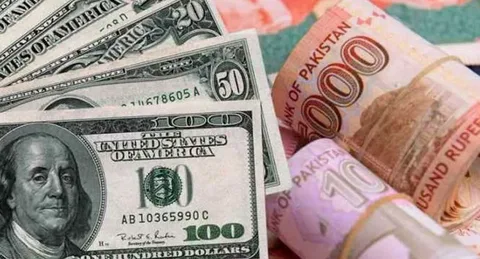Introduction To Dollar Rate in Pakistan
The exchange rate of the dollar in Pakistan is one of the most closely monitored financial indicators. As a developing economy, Pakistan’s financial health is highly influenced by the value of foreign currencies, particularly the U.S. dollar. The dollar rate today in Pakistan is a key determinant of the country’s import and export dynamics, inflation rates, and overall economic stability. In recent times, exchange rates have become increasingly volatile, reflecting global economic uncertainties and domestic financial challenges.
In this article, we will explore the current trends in the dollar rate in Pakistan, how these fluctuations affect the economy, and what the outlook may be for the near future. We will also touch upon the pound rate today in Pakistan, as both the U.S. dollar and the British pound significantly impact trade and foreign reserves.
1. The Importance of the Dollar Rate in Pakistan
The U.S. dollar plays a pivotal role in Pakistan’s economic framework. Many of the country’s major imports, including oil, machinery, electronics, and food products, are priced in dollars. Therefore, any fluctuation in the dollar rate directly affects the cost of these essential goods. A weaker Pakistani Rupee (PKR) against the dollar leads to higher import costs, which can trigger inflation and increase the cost of living for the average citizen.
Additionally, the dollar rate in Pakistan has a significant impact on the debt servicing obligations of Pakistan. A large portion of the country’s external debt is denominated in U.S. dollars, so when the dollar strengthens, Pakistan’s debt repayments become more expensive. This situation has been exacerbated by the depreciation of the rupee in recent years, leading to a greater burden on the national economy.
2. Factors Influencing the Dollar Rate in Pakistan Today
The dollar rate in Pakistan is not a static figure and can change frequently due to several domestic and international factors. Some of the key drivers that influence the exchange rate include:
a. Demand and Supply of the Dollar
Like any commodity, the value of the dollar is driven by supply and demand. If the demand for the dollar increases, its price rises, and the Pakistani rupee depreciates in comparison. This demand is typically fueled by the need for foreign exchange to pay for imports or service foreign debt.
b. Foreign Exchange Reserves
The State Bank of Pakistan (SBP) manages the country’s foreign exchange reserves, which play a crucial role in stabilizing the dollar rate. When reserves are depleted, the SBP has less ability to intervene in the forex market, leading to greater exchange rate volatility. Conversely, healthy reserves give the central bank the power to inject dollars into the market to stabilize the currency.
c. Trade Balance
A country’s trade balance (the difference between its exports and imports) also influences the exchange rate. Pakistan has traditionally run a trade deficit, meaning it imports more than it exports. This increases the demand for dollars, as businesses need foreign currency to pay for imported goods, driving up the dollar rate.
d. Remittances
Remittances from Pakistanis working abroad are an important source of foreign exchange. When remittances increase, they contribute to a greater supply of dollars in the market, helping to strengthen the rupee. Conversely, any decline in remittances can put upward pressure on the dollar rate.
e. Political and Economic Stability
The political climate and economic policies of Pakistan also play a crucial role in determining the dollar rate. Political instability, economic uncertainty, or changes in government policies can lead to capital flight, where investors move their assets out of the country, leading to a weaker rupee. On the other hand, sound economic policies and political stability can enhance investor confidence, helping to stabilize the exchange rate.
3. The Impact of the Dollar Rate on Pakistan’s Economy
The fluctuations in the dollar rate in Pakistan have widespread implications for different sectors of the economy:
a. Inflation
One of the most immediate impacts of a high dollar rate is inflation. As the cost of imports rises due to a weaker rupee, the prices of goods such as fuel, food, and other essential items increase. This leads to a higher cost of living and erodes the purchasing power of consumers. In recent years, Pakistan has witnessed double-digit inflation, in part due to the rising dollar rate.
b. External Debt
Pakistan’s external debt has been a growing concern in recent years. A significant portion of this debt is denominated in dollars. As the rupee depreciates, the cost of servicing this debt increases, putting additional strain on government finances. In 2024, debt repayments are expected to rise further, especially if the rupee continues to weaken.
c. Exports and Imports
A depreciating rupee can be a double-edged sword for the economy. On one hand, a weaker rupee makes Pakistani goods more competitive in international markets, which could boost exports. However, since Pakistan relies heavily on imported raw materials and machinery, the cost of these imports increases, which can offset any benefits gained from higher export earnings.
4. The Pound Rate Today in Pakistan: An Overview
While the U.S. dollar dominates Pakistan’s foreign exchange market, the British pound (GBP) is also an important currency, particularly for trade with the United Kingdom and other Commonwealth nations. The pound rate today in Pakistan is influenced by similar factors as the dollar rate, including demand and supply, foreign exchange reserves, and the overall health of the Pakistani economy.
Like the dollar, fluctuations in the pound rate can have significant implications for trade and investment. Many Pakistani expatriates live and work in the UK, and their remittances contribute to the country’s foreign exchange reserves. A strong pound can benefit these remittance flows, while a weaker pound may reduce the value of remittances sent to Pakistan.
a. Trade with the UK
The United Kingdom is an important trading partner for Pakistan, particularly in sectors such as textiles, apparel, and food products. A higher pound rate can make Pakistani exports to the UK more competitive, helping to boost trade. However, for businesses that rely on importing goods from the UK, a stronger pound can increase costs, which may be passed on to consumers.
b. Foreign Direct Investment
The UK is also a key source of foreign direct investment (FDI) in Pakistan. A stable or strong pound rate can encourage British companies to invest in Pakistan, contributing to job creation and economic growth. Conversely, a weakening pound may lead to reduced investment flows.
5. Forecast for the Dollar and Pound Rates in Pakistan
Predicting the future movement of the dollar and pound rates in Pakistan is challenging due to the many variables involved. However, analysts suggest that continued economic reforms, an increase in foreign exchange reserves, and a reduction in the trade deficit could help stabilize the rupee in the medium to long term. In the short term, however, external factors such as global inflation, rising oil prices, and geopolitical tensions may keep the dollar and pound rates volatile.
6. Conclusion
The dollar rate today in Pakistan is a crucial indicator of the country’s economic health, with wide-ranging implications for inflation, debt, trade, and investment. The pound rate today in Pakistan also plays a significant role, particularly in trade and remittances. Understanding the factors that influence these exchange rates is essential for businesses, policymakers, and consumers alike.
As Pakistan continues to navigate through economic challenges, efforts to stabilize the rupee and manage foreign exchange reserves will be key to ensuring long-term growth and stability. The coming months will likely see continued fluctuations in the dollar and pound rates, but with the right policy measures, Pakistan can mitigate some of the negative impacts on its economy.




